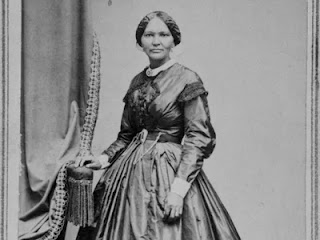Read Part One HERE
In this post I continue the story of a woman named Elizabeth Hobbs Keckley. She lived from 1818 - 1907. At fourteen, Elizabeth was sent to North Carolina to work for Col. Burwell's son, Robert. Robert and his wife's estate in Hillsborough, NC, was not financially successful and they hired Elizabeth out to a white neighbour That neighbour brutally and frequently beat Elizabeth and forced her into a sexual relationship for four years. The non-consensual relationship resulted in the birth of Elizabeth's only son, George, in 1842.
That same year, Elizabeth and her son were sent back to the Burwell plantation in Virginia. Col. Burwell then gave Elizabeth, her son George and her mother Aggy to his daughter (and Elizabth's half-sister) Ann Garland, as a wedding gift.
Around 1847, the Garlands moved to St Louis to make a new start. Elizabeth, her son and her mother had to accompany them. To make money, the Garlands decided to hire out Elizabeth's mother Aggy to clean other white families' houses. Elizabeth was afraid this would be too hard on her aging mother, and she begged to make money in her mother's place. She used the skill her mother had taught her: sewing. Elizabeth quickly earned a reputation as one of the best dressmakers and received orders from some of the wealthiest women in the city.
As an enslaved woman, Elizabeth's earnings went to her owner, but Elizabeth made enough money to keep her mother from being hired out. In 1850, Elizabeth married James Keckley. However, the marriage was not successful and the couple formally separated in 1860.
In 1852, Elizabeth asked the Garlands for her freedom. They initially refused, but later told her they would emancipate her and her son George for US$ 1,200. However, this price was impossible. As she searched for ways to raise the money, her plight caught the attention of some of her wealthy clients. They raised the money for Elizabeth to purchase her and her son George's freedom on November 15, 1855.
Read Part One Hundred And Forty-Five HERE









